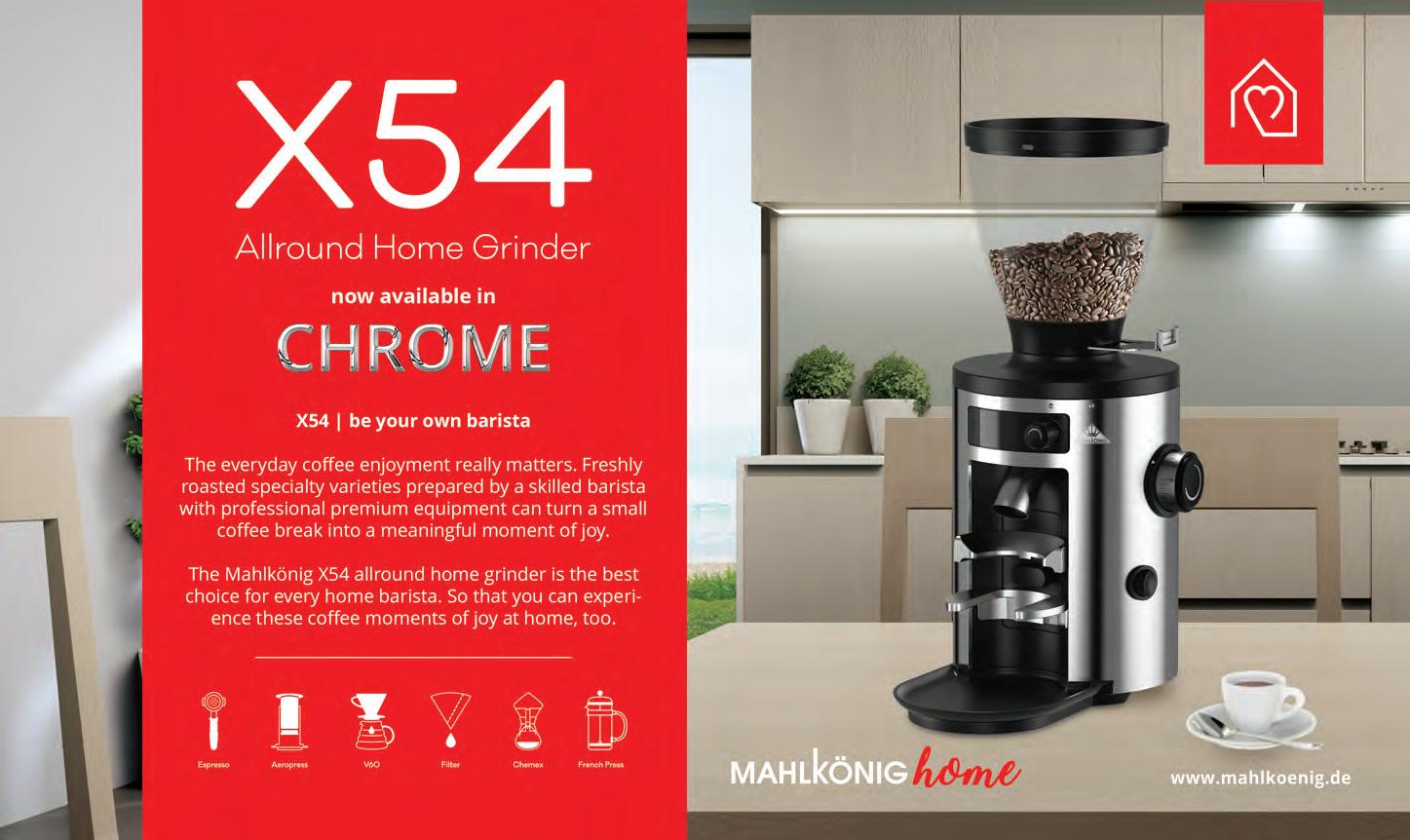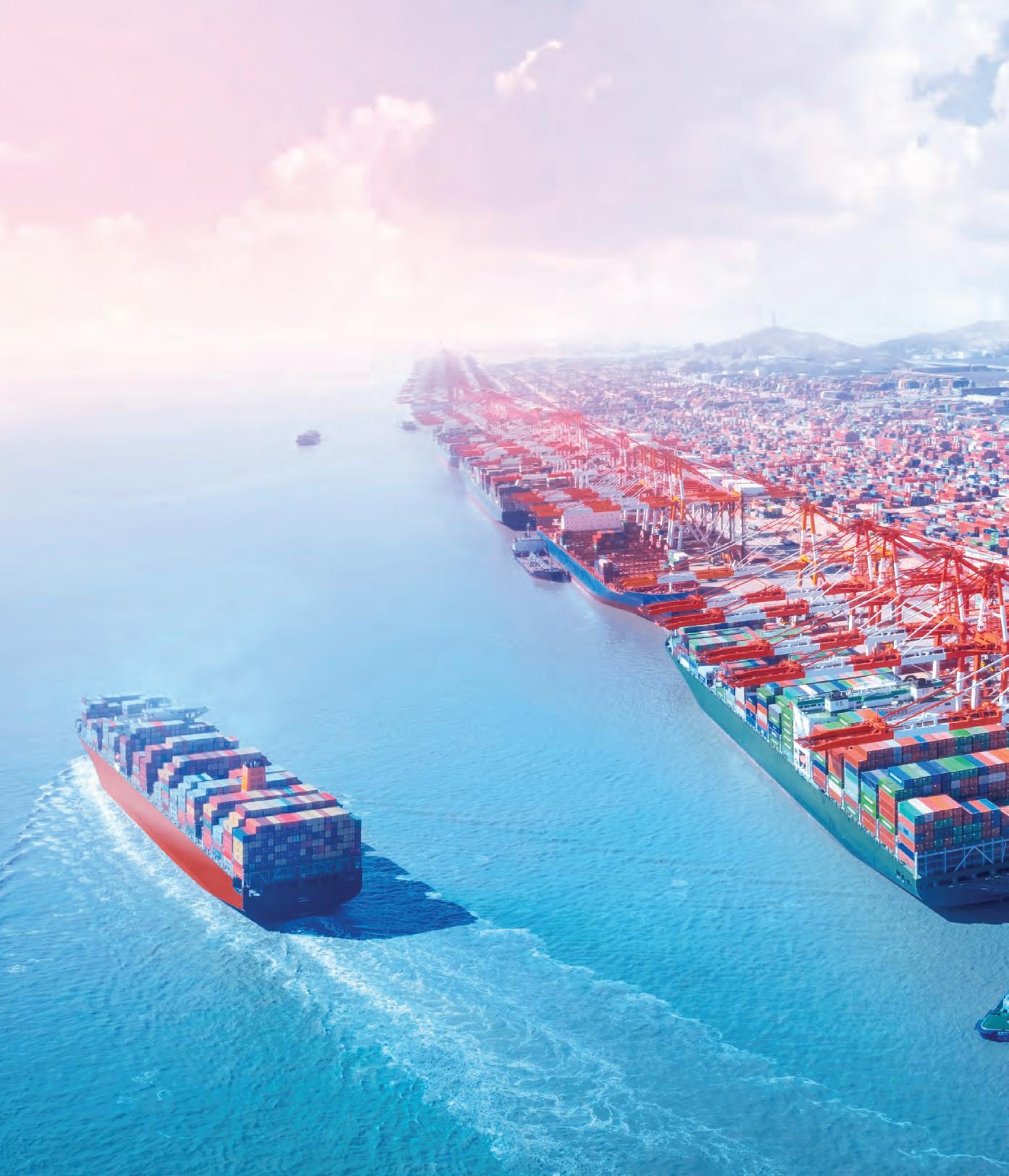
11 minute read
A SHIFTING SUPPLY CHAIN
GLOBAL COFFEE REPORT EXPLORES HOW COVID-19 HAS CHANGED THE LOGISTICS OF TRANSPORTING COFFEE, AND HOW TRADERS, SHIPPING COMPANIES, AND ROASTERS ARE PIVOTING TO MEET CONSUMER DEMAND.
Transporting green beans requires a plan as meticulous and thorough as a James Bond mission. It involves coordinating harvest seasons with local and international logistic companies, correct handling to prevent oxygen contamination and maintaining consistent humidity levels, and that was before COVID-19 turned the logistics world on its head.
International food and agri-business supplier olam food ingredients (ofi) experienced the immediate impact firsthand, having transported green coffee from origin countries to roasters around the globe for more than 30 years.
“There are so many variables in shipping that come as a surprise even with the best of planning. Throughout COVID, we’ve seen first-hand how a single bottleneck causes a ripple effect throughout the supply chain,” says Marc Lissauer, Director of Coffee Logistics at ofi.
Lissauer points to Colombia, where government-enforced curfews during early COVID-19 outbreaks decreased shipping and production capabilities. Soon after, strikes and protests shut down the country’s main roads, drastically reducing exports again, despite demand for coffee remaining high.
“Our extensive global team and presence in origins such as Colombia put us in a favourable position to navigate our way through these roadblocks – both literally and figuratively,” says Lissauer.
“Having inventory available in each destination is one way we’ve been able to continue supplying green coffee to our roasting partners. Others, meanwhile, have been forced to buy spot coffee at increasing prices or swap to alternative origins that offer similar flavour profiles.”
As a result of these roadblocks, Lissauer says there have been fewer vessels and containers able to meet surging global demand.
“Ports and vessels become filled with full containers that reduce both the number of available vessels and empty containers on the water,” he says. “With this increased competition for space and containers, there has been an increase in shipping prices.”
In 2020, integrated container logistics company A.P Moller-Maersk shipped more than 100,000 coffee containers via ocean carriers from Brazil. As a result of local container shortages, Luiz Gouveia, Sales Coordinator of Maersk Group brand Hamburg Sud, says the company became accustomed to expecting delays.
“We found when we exported containers to ports across the globe, they would probably become stuck at terminals,” Gouveia says.
This can be caused by any number of reasons, including irregular shipping schedules with an influx of boats arriving at the same time, understaffing of terminal workers due to COVID-19 outbreaks, lockdowns or capacity limits, and truck and equipment shortages. These factors can result in 20 or more boats waiting in a port at any one time.
Gouveia cites the Rotterdam port, one of the largest seaports in Europe, and the Port of Los Angeles in America as some of the hardest hit.
“In September, we saw up to 60 to 70 vessels waiting at one time in the Port of Los Angeles,” he says.
Gouveia adds that Maersk, along with countless other shipping companies were faced with the challenge of either utilising more fuel to make up for lost time spent at the terminals or “blank sailing” – skipping ports.
“There is, however, an environmental issue with burning more fuel and skipping ports adds to the backlog of items already waiting at ports,” he says. “Globally, there has been a vessel shortage, so it is not as simple as sending more vessels to collect the blanked ports.”
With so many contending factors, Maersk worked to maintain the high standard conditions of its dry food grade containers to ensure coffee quality.
According to Jean Nicolas Wintgens in his book Coffee - Growing, Processing, Sustainable Production, green coffee is susceptible to absorbing water from its surroundings, which dilutes its flavour and aroma.
As such, when transporting coffee, its temperature and humidity must be carefully monitored and held in conditions of less that 60 per cent humidity. Exposure to warm temperatures, along with too much oxygen, also increases the bean’s metabolic activity, causing a loss of aroma.
Transport by air, however, remains very expensive due to limited space says Gouveia, with degassing and oxygen exposure always a threat. According to the United States Census Bureau, in 2021 air transport of green beans cost an average of US$16 per kilogram, compared to ocean shipping of green beans which cost an average of US$3 per kilogram.
For this reason, maritime shipping has remained the preferred method for transporting coffee internationally, which is why Gustavo Pereira, Senior Marketing Analyst at Maersk says it’s important to improve the problems seen today.
“We are shifting to offer a complete end-to-
end solution, as these delays have demonstrated the need for an integrated view of the entire supply chain,” he says. “Through extending Maersk’s transport services to railway lines which allows us to transport coffee from origin to retail stores, and allows greater visibility for our customers.”
Pereira adds that this period has also highlighted the need for more sustainable shipping solutions. As such, in 2023, Maersk will introduce the first of eight ocean container vessels, which will operate on carbon neutral methanol, reducing one million tonnes of carbon dioxide annually.
Alongside these trends, Raphaelle Hemmerlin, Head of Logistics and Operational Efficiency at Sucafina – a multinational coffee merchant – says over the past year she has noted a tendency for shipping companies to favour the highest paying goods with the lightest weight.
“This has negatively impacted the coffee supply chain as coffee is considered ‘heavy goods’ for shipping lines,” Hemmerlin says. “We have also seen shipping prices increase six-times [since] 2019 levels.”
As a coffee merchant, Hemmerlin says Sucafina’s biggest challenge was keeping in contact with its logistics partners during delays.
“Moving coffee has many aspects. We had to manage communications with the truck drivers, quality controllers, as well maintaining aspects such as the release of the physical documents. On top of this, we saw many constraints between countries’ borders,” says Hemmerlin.
“This slowed the availability of truckers down a lot, and it also slowed the overall transit time of goods to reach the ports, so keeping that communication line clear was key.”
This same principle has been applied to roasters and buyers around the world.
“We track shipments and containers on daily basis, and we offer visibility with reports and updates to our customers on at least a weekly basis,” says Hemmerlin. “If our customers can’t get a shipment as per their initial plan, we work with our commercial team to suggest alternatives for our customers to be supplied with a coffee of equivalent quality.”
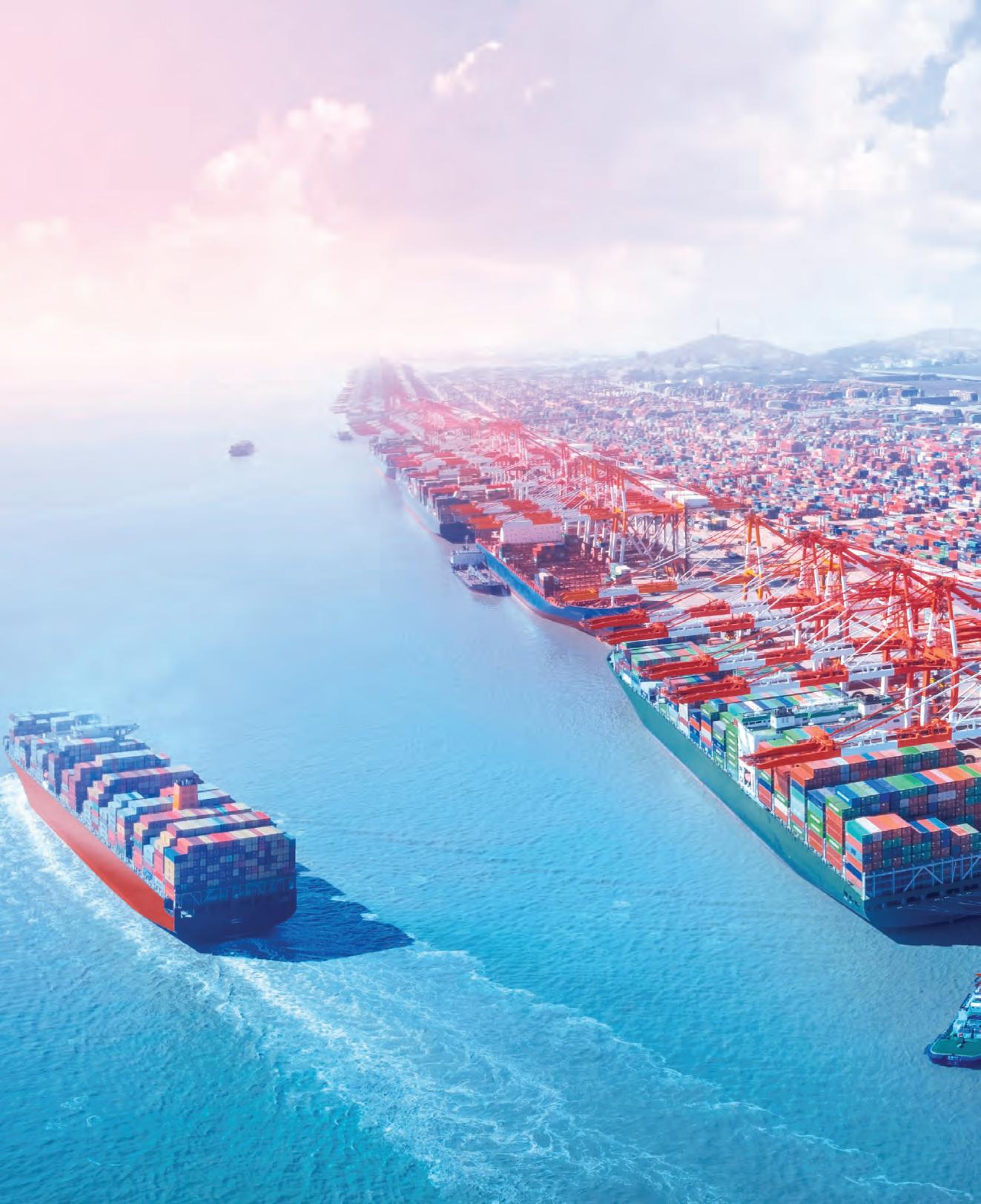
Green beans must be transported in conditions of less than 60 per cent humidity. “THERE ARE SO MANY VARIABLES IN SHIPPING THAT COME AS A SURPRISE EVEN WITH THE BEST OF PLANNING. THROUGHOUT COVID, WE’VE SEEN FIRST-HAND HOW A SINGLE BOTTLENECK CAUSES A RIPPLE EFFECT THROUGHOUT THE SUPPLY CHAIN.”
Marc Lissauer
Director of Coffee Logistics at ofi.
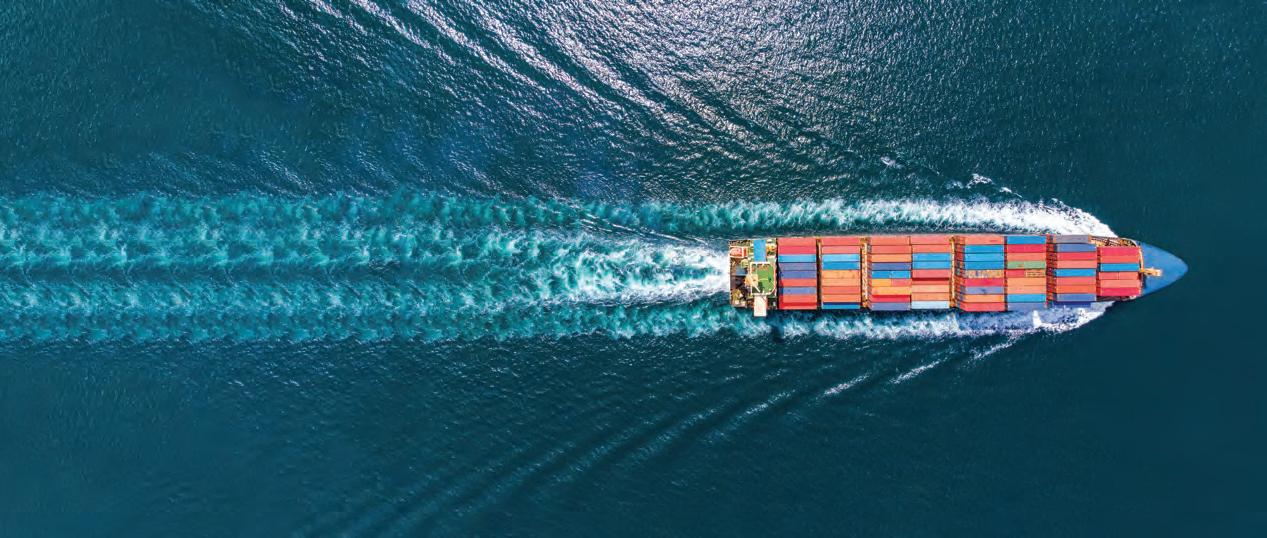
Hemmerlin says that coffee buyers around the globe have shown an understanding of the challenges, with most ready and willing to look at all possibilities as long as discussions are constant and transparent.
“We’ve moved to a new landscape for logistics, which requires a lot of innovation and learning, and customers have seemed to understand that,” says Hemmerlin.
Hemmerlin says the conditions we’re seeing now are the result of a “perfect storm”.
“There has been a 21 per cent overall growth in world-wide container volumes to, from, and in between North America, according to container shipping publication Dynaliners’ 2021 report,” she says. “This has created congestion in critical port terminals such as the West Coast of America or in China’s ports.”
Jason Miller, Associate Professor of Logistics at Michigan State University says particularly with the import supply chain, the sector functions with minimal excess capacity and low margins, resulting in limited room for increased demand, especially over a prolonged period.
“You can’t quickly add another terminal to a port or build warehouses and, likewise, quickly train new truck drivers and train engineers; it’s a classic example that demand can shift quickly, but supply cannot and when that happens, two things happen: prices can go up quickly, and wait times increase exponentially, which is exactly what we’re seeing today,” he says.
Miller adds in the US, the change in consumer demand has played a role in coffee shipping delays.
“When the lockdowns occurred, we had a record government stimulus, but people weren’t able to spend on services and instead bought durables which just spurred an increase in demand of products both globally and particularly from East Asia,” he says.
As such, despite Vietnam being America’s third largest importer of coffee in 2020, Miller predicts imports will remain low due to these COVID-related delays. His analysis of Census Bureau import data for coffee indicates that, through the first nine months of 2021, metric tons of coffee imports from Vietnam are down 29 per cent from the first nine months of 2019.
Nguyen Coffee Supply, an American-based specialty Vietnamese coffee importer and roaster, has been impacted by such delays.
“There have been incredible delays ordering coffee from Vietnam and shipping coffee to our customers. Specifically, with global freight, we’ve seen the cost increase four to five times, and as
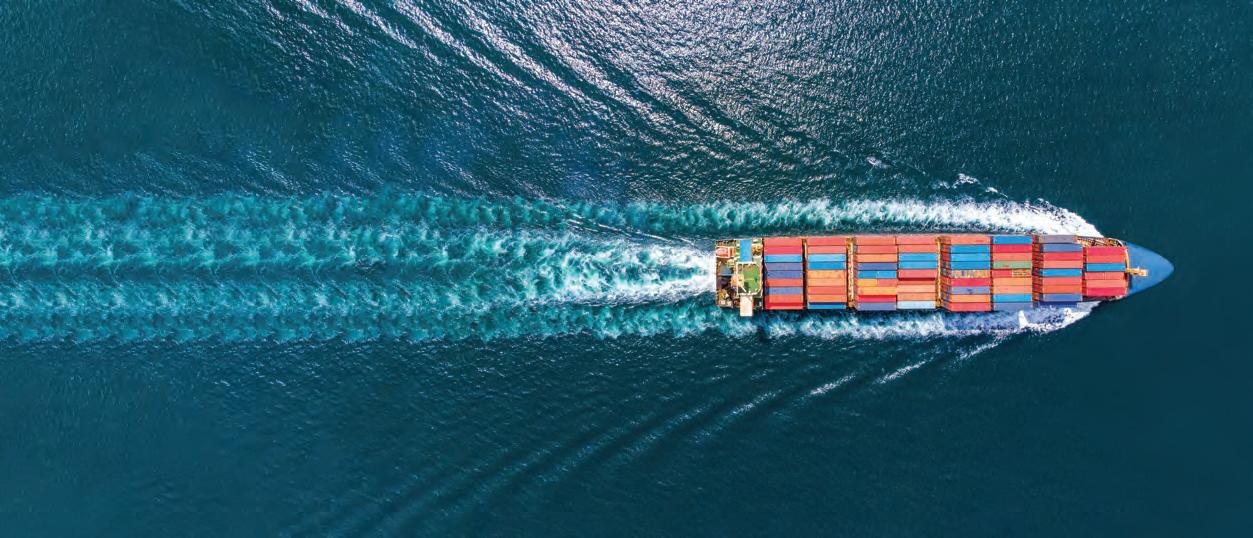
According to container shipping publication Dynaliers’ 2021 report, container volumes have grown 21 per cent.
a small business, we’ve had to eat this cost as there is no way around it,” says Nguyen Coffee Supply Founder Sahra Nguyen.
“We’ve had to order our coffee from Vietnam much earlier to arrive on time, factoring in the delays with global freight shipping. We don’t stockpile coffee, but have had to manage our inventory appropriately to account for the delays.”
Domestically, Nguyen says carriers delivering goods to customers are also overwhelmed with the rise of online shopping. While some customers have been understanding about shipment delays, she says there are still many who expect deliveries to be as quick as Amazon Prime or offering “next day” options.
She adds that large companies like Amazon have their own carrier system, which enables them to make such shipping guarantees. Small businesses like Nguyen Coffee Supply work with other carriers, and although most have no control over carrier systems like USPS or UPS, Nguyen says customers often place the onus on brands.
For customers, she says it’s all about communicating the realities of the carrier system and assist with managing expectations around shipping timelines.
“I predict that people will have to order
much earlier to compensate for their crowded and congested global freight supply chain,” she says.
Like many suppliers around the globe, satisfying consumer demand at a time where transportation was volatile was one of Lavazza’s biggest challenges during the pandemic.
To mitigate supply shortages in 2021, Lavazza’s supply and operations team reviewed and overhauled the frequency of shipments and lead times to ensure stock arrived on time.
“Pre-COVID, there may have been the ability to rely on ‘just in time’ mentality, or for one party in the supply chain to harbor the majority of the inventory. This is no longer feasible or wise, especially on long distance freight,” says Lavazza APAC Regional Director Simone Chimini.
Looking forward, Chimini says agility and flexibility will continue to play a key role in helping the Italian roaster manage volume and transportation of coffee evenly across its global network.
“There is no one-size-fits-all solution to implement as the new industry standard. So, moving forward, the best resources in our supply chain toolkit will be adaptability and proactivity,” he says.
“We know that ports and airports are influenced by state and international borders, so we have created guidelines into the new year to be able to pivot where needed.”
Lavazza does not anticipate delays will improve in the short-term, nor that shipping prices will reduce at least in the first half of 2022. In the medium-long term however, Chimini predicts shipping prices will come down, but not necessarily at the level of pre-COVID.
According to Associate Professor Miller, the next question the industry will be asking is “what do we, or can we, feasibly change within the supply chain?”
“There’s only so much warehousing capacity we can add before we begin struggling with labour availability, which is one of the issues we’ve started to see in the US,” Miller says.
He predicts however, that shipping container prices, for coffee and the wider industry, will not revert to pre-COVID levels.
“For over a decade before the onset of the COVID-19 pandemic, ocean carriers just weren’t making any money. This was due to a surplus of global vessels and containers coming online the same time that the Great Recession hit in 2008 and 2009,” he says.
“Given the high degree of concentration in the container shipping sector, I believe the carriers have learned pricing discipline and will avoid adding too much capacity.”
When transport schedules will return to “normal”, says Miller, is unpredictable.
“It’s difficult to estimate because we don’t yet have a sense for when consumer behaviour will change again and people start to buy less durables, which will drive down demand for imports and improve shipping time for industries such as coffee,” he says.
“We do know, however, that all these extra container lines being built around the globe won’t come online until 2023, so we still have a period of waiting before things shift again.” GCR
